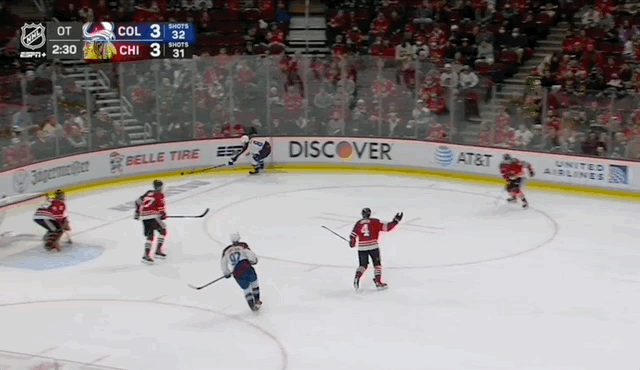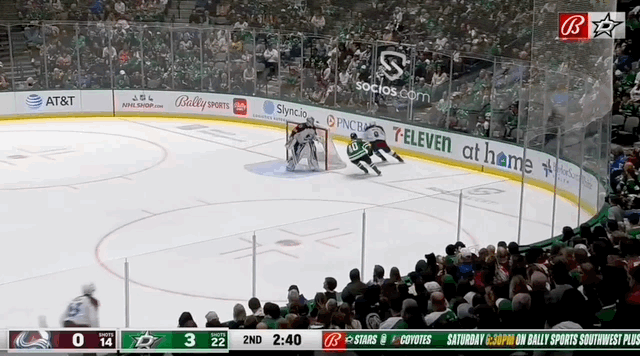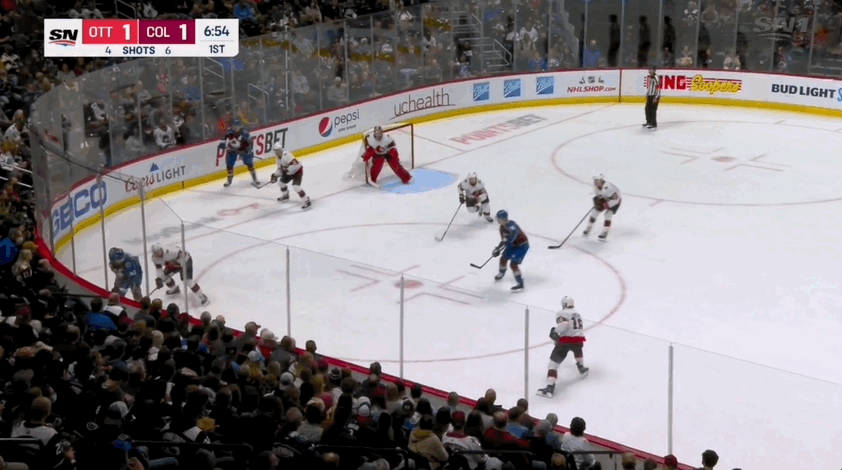What’s so special about Cale Makar? You probably got a nice glimpse of it when he scored the game-winner in overtime against Chicago earlier this week and it caught the attention of the sports world.

Makar’s been in some sort of ‘NHL awards’ conversation in each of his first two seasons — first the Calder, then the Norris — and this year probably won’t be any different. He may not be the ‘stereotypical defenceman’, but there’s nothing wrong with that. Rather, he, along with Adam Fox last year in the race for the Norris, forced many to re-think how the award should be considered, and on a grander scale, how the position should be analyzed.
In today’s NHL, puck possession is the name of the game. Players, including defenders, have to be able to skate. The best defence isn’t always a slow approach that relies on being peppered with shots against and blocking scoring chances. It can be a more proactive approach of looking for stick plays to break up chances or force takeaways, and quickly transition play right back up the ice.
That’s something Makar’s more than able to do. He has seven takeaways this season at 5-on-5 through 26 games, while his primary partner, Devon Toews, has nine. From there, he’s able to bring the puck out of the defensive end with control, whether he makes the outlet pass or carries it out himself, which is what he tends to do. Makar’s 9.84 carry-outs rank 13th in the league among defenders, and are followed by a successful play about 79 per cent of the time.

When their leading defender is on the ice at 5-on-5, the Avalanche concede only 1.84 expected goals against per 60 — that’s the seventh-best mark among blue liners in the league.
Makar’s game relies on his skating ability; he’s able to weave around his opponents to transition the puck out of danger in the defensive zone, sometimes all the way up to the offensive end. Zone entries are generally jobs for a team’s forwards, and that’s no different in Colorado. But among defenders in the league, few skate the puck in at a higher rate than the Avalanche back at 5-on-5. Makar’s 5.83 attempts per 60 ranks fourth in the league only behind Roman Josi, teammate Jacob MacDonald, and Darnell Nurse. About 53 per cent of the time there’s a successful play to follow those carry-ins.

Sometimes, those plays end in a shot attempt — whether off Makar’s stick, or one of Colorado’s skilled forwards. Despite missing time to injury, he still leads the team in all situation shot attempts and is second at 5-on-5 behind only Nathan MacKinnon. And those shots come both off the rush and cycle. Unlike some defenders, including his partner Toews, Makar’s not going to be seen with his stick in the air waiting to rip a one-timer (he’s more of the setup-guy for those shots). He will, however, be found making his way to the slot at a higher rate than most defenders; his 2.33 slot attempts per 60 rank 21st.

While Makar has no problem taking the shot himself, he often plays alongside some of the best forwards in the league — so it sure doesn’t hurt that he can set up his teammates.
The Avalanche see a lot of passing from their blue liners when Toews and Makar are on the ice. The former actually has the third-highest pass attempt rate in the offensive zone among the position, while the latter ranks 41st. Few defenders set their teammates up with more passes off the rush than Makar, or move the puck east-to-west more. Plus, he’s more than able to thread the skaters around him a pass to the slot.
More than just setting up in the offensive zone is Makar’s ability to keep plays alive. He can stick-handle himself out of danger, even while under pressure.

Because he’s both shifty and willing to shoot, he can keep defenders guessing. Putting too much attention on Makar can easily burn a player if they overcommit, or don’t keep an eye on who else is on the ice — that’s one of the toughest parts about playing the Avalanche, especially when their best is deployed.

With his skating ability, he buys himself time and space, and can pivot away from defenders who don’t anticipate his next movements.

All of that culminates to an impressive 3.23 expected goals for rate while he’s on the ice at 5-on-5.
Then, of course, there are his special teams efforts. While Makar didn’t play short-handed much at all in his rookie year, he did see some usage last year, and is seeing a slight uptick this year (though he’s only at about 18 per cent of the available minutes right now).
Rather, it’s the power play where he really makes his mark. The loaded first unit plays the majority of the available minutes (around 66 per cent), and the team’s offensive generation and finishing ability puts them towards the top of the league.

While he doesn’t move the puck at the same rate as other top power play quarterbacks (his pass attempts per 60 in the O-zone land him 17th in the league among all defencemen), Makar is one of the most efficient when he does, with a 93 per cent success rate. His lateral passes almost never fail — of his 62.6 attempts per 60, only 1.7 per cent don’t connect.
Plus, he’s more than willing to shoot while on the man-advantage including from the quality areas. Makar’s 10th in slot attempts per 60. His skating plays into that — take the clip against the Flyers below, where he’s able to change his pace in the neutral zone to move around the penalty killers.

Makar’s efforts, all together, add up on the score sheet. In Colorado, he’s fifth in points with 28 in all situations and second in goal scoring with 14 behind only Mikko Rantanen. His scoring 2.66 points per 60 rate actually puts him second to Toews (2.77 per 60). Relative to the league, despite missing time, Makar’s 28 total points put him sixth among defencemen. And no defenceman has scored as many goals as Makar’s 14; the next best is Josi’s 11.
https://twitter.com/iyer_prashanth/status/1469786550678532105
Defensive scoring is what often puts a player on the map in the Norris rate. But it’s not all that puts Makar in the conversation; his overall impact should keep him (and his partner Toews) in contention for the second straight season. And he’s only just getting started in the NHL.
Data via Sportlogiq
[relatedlinks]



 1:38
1:38 0:49
0:49
COMMENTS
When submitting content, please abide by our submission guidelines, and avoid posting profanity, personal attacks or harassment. Should you violate our submissions guidelines, we reserve the right to remove your comments and block your account. Sportsnet reserves the right to close a story’s comment section at any time.